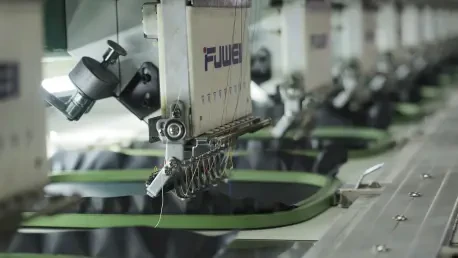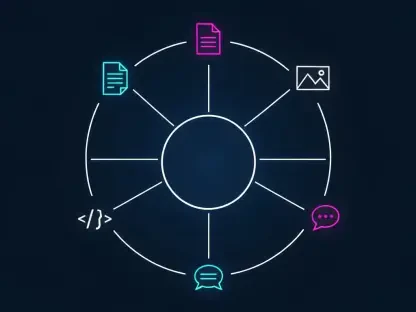Business process automation (BPA) is becoming a cornerstone in the technological landscape as industries experience unprecedented growth and transformation. BPA represents a strategic shift aimed at optimizing intricate business processes, reducing human errors, and lowering operational costs. As corporations strive for streamlined operations and increased productivity, BPA emerges as a vital tool in enhancing customer experience and maintaining a competitive edge in a rapidly evolving market. This surge in BPA adoption aligns with ongoing digital transformations, reflecting a dynamic pivot across various sectors seeking enhanced functional efficiency.
Market Growth and Dynamics
Expansive Market Outlook
The outlook for the business process automation market indicates substantial growth potential. With projections forecasting an increase from USD 11.74 billion in 2023 to USD 34.68 billion by 2032, the market is poised to experience a compound annual growth rate (CAGR) of 12.4%. This anticipated expansion is a testament to the swelling demand from businesses aiming to reinforce their operational efficiency through automation solutions. Companies are increasingly recognizing the strategic advantage BPA offers in minimizing manual errors, boosting productivity, and streamlining workflows, ultimately fostering a more competitive environment. As industries continue to embrace technological advancements, the BPA market stands central in facilitating this transition towards optimized and agile operations.
Key Drivers of Growth
Operational efficiency is a crucial driver behind the robust adoption of BPA solutions. Enterprises are realizing the intrinsic benefits BPA provides in eliminating discrepancies and enhancing performance, essential for sustaining a competitive advantage. This realization underpins broader business strategies focused on agility, efficiency, and cost-effectiveness. As organizations shift towards more lean practices, BPA serves as an enabler of these objectives, effectively automating routine and complex processes alike. Furthermore, the pursuit of customer satisfaction through tailored services is propelling companies to integrate BPA into their frameworks, offering faster and more reliable interactions. By leveraging BPA, businesses position themselves for sustained success amid the ever-shifting demands of the modern marketplace.
Digital Transformation Synergy
Integration of AI and Machine Learning
Business process automation is increasingly intertwined with digital transformation initiatives, showcasing a strategic pivot towards comprehensive technological integration. By embedding artificial intelligence (AI) and machine learning within BPA frameworks, organizations are unlocking advanced predictive analytics capabilities, facilitating informed decision-making and proactive problem-solving. These technologies enable organizations to forecast potential bottlenecks and devise strategic interventions, enhancing overall process efficiency. The synergy between digital transformation and BPA is further augmented by AI’s ability to offer prescriptive insights based on historical data patterns, driving improvements in service delivery and operational management. This integration reflects a pivotal evolution in business operations, paving the way for more intelligent and adaptive systems.
Enhanced Organizational Decision-Making
The convergence of digital transformation and business process automation not only enhances the technological framework but significantly enriches organizational decision-making processes. AI and machine learning’s role within BPA systems empowers businesses to operate with heightened foresight, leveraging data-driven insights to preemptively address challenges. This anticipatory approach enables companies to adapt swiftly to market dynamics, optimizing resource allocation and refining strategic initiatives. Furthermore, the incorporation of these technologies has introduced an unprecedented level of automation to workflows, supporting businesses in achieving efficiency goals while maintaining service quality. As organizations continue their journey through digital transformation, the cohesive integration of AI and machine learning within BPA solutions is set to redefine industry benchmarks and operational methodologies.
Sector-Specific Adoption
Dominance in BFSI Sector
Within the BFSI (Banking, Financial Services, and Insurance) sector, business process automation has established itself as an indispensable asset, driven by a pressing need for efficient data management and cyber resilience. This sector’s inclination towards BPA is propelled by the demand to enhance customer engagement through personalized financial offerings while ensuring robust cybersecurity frameworks to protect valuable data. Financial institutions face increasing pressure to meet regulatory compliance and streamline transaction processes, making BPA a vital component in their operational strategy. Moreover, the seamless integration of BPA allows BFSI entities to achieve rapid process optimization, delivering refined customer experiences and ensuring strategic advantage in an increasingly competitive marketplace.
Rising Trends in IT and Telecom
Parallel developments in the IT and telecom industries underscore a pronounced growth trajectory in BPA adoption. With swift AI assimilation, these sectors are aiming for streamlined service delivery and improved customer experiences through automation methodologies. As these industries adapt to evolving client expectations and technological shifts, BPA serves as a pivotal mechanism in refining operations, reducing costs, and ensuring service consistency. The role of BPA in IT and telecom extends beyond mere process automation to encompass a broader aspiration for technological excellence and competitive superiority in a dynamic business landscape. This strategic integration not only accelerates innovation but also supports future advancements in IT infrastructure and telecom networks.
Scale of Organizational Adoption
Large Enterprises Lead
The adoption of business process automation among large enterprises reflects a concerted effort to digitize operations and augment customer interactions through strategic, data-driven insights. These organizations capitalizing on BPA solutions are driven by the pursuit of operational efficiency, enhanced decision-making capabilities, and innovative customer support strategies. The breadth and complexity typical in large enterprise operations necessitate adopting BPA frameworks that foster agility and sustainability. By harnessing automation’s power, these enterprises are fortifying their competitive stance in the marketplace, addressing workflow inefficiencies and strengthening customer relationships. The operational agility imparted by BPA empowers large companies to navigate challenges effectively and embrace opportunities promptly, facilitating continuous growth and adaptability.
SMEs’ Accelerated Growth
Conversely, small and medium enterprises (SMEs) are showing remarkable BPA adoption, influenced by increasing accessibility and awareness of its transformative benefits. This segment is experiencing newfound agility and productivity insights attributed to BPA implementation, redefining traditional operational models. As BPA solutions become more affordable and user-friendly, SMEs are capitalizing on these innovations to drive process efficiencies and gain competitive ground. Empowered by the ability to streamline operations at reduced costs, SMEs are not only achieving faster growth but are also enhancing their resilience in dynamic economic environments. The rise of BPA among SMEs signifies a strategic shift towards embracing technological advancements and exemplifies how small-scale businesses can leverage automation for sustainable and scalable growth.
Geographical Insights
North American Pioneers
North America, with its landmark status in technological adoption and significant investments in AI and cloud computing technologies, retains its leadership position in the business process automation market. The United States, as a hub of innovation, exemplifies this regional dominance through its strong digital transformation initiatives and pioneering advancements in automation solutions. Notable tech giants, including IBM, Microsoft, and UiPath, are at the forefront of innovation, reinforcing regional expertise and adoption rates. This positioning enables North American enterprises to leverage cutting-edge BPA technologies effectively, fostering enhanced operational efficiencies and strategic advancement. Additionally, Canada’s focus on complying with privacy regulations and adapting to evolving work patterns underscores its commitment to optimization and service excellence through automation.
Emerging Asia Pacific Market
Asia Pacific is rapidly ascending as a key player in the global BPA landscape, driven by robust industrialization, digitalization efforts, and an expanding startup ecosystem. Nations like Japan and South Korea are spearheading this growth, characterized by a cultural emphasis on efficiency and innovation. The integration of BPA within these countries is bolstered by governmental support and private sector investments, creating an environment ripe for extensive market expansion. This region’s adoption reflects a strategic effort to embrace global technology trends, improve competitive positioning, and stimulate economic growth through automation adoption. As Asia Pacific continues to gain momentum aesthetically adapting to BPA innovation, it positions itself strategically amid advancements in business automation methodologies.
Challenges and Restraints
Organizational Change Resistance
Despite optimistic projections, BPA market growth is impeded by resistance to organizational change, often rooted in employee concerns over job security. As companies integrate advanced technologies into their operations, adapting to new paradigms presents significant challenges. Employees may perceive automation as a threat to traditional job roles, fostering reluctance towards BPA adoption. Overcoming this resistance requires comprehensive change management strategies, emphasizing the value of BPA in enhancing roles and creating new opportunities. Addressing concerns about displacement and promoting understanding of automation’s benefits is paramount to ensuring successful implementation and integration. Cultivating a workforce prepared to adapt to technological advancements is instrumental in overcoming resistance and facilitating seamless transitions in organizational practices.
Integration with Legacy Systems
Technical challenges associated with integrating BPA solutions with existing legacy systems present formidable barriers to widespread adoption. These systems are often complex and outdated, hindering the seamless integration of modern automation technologies and subsequently incurring high costs and resource demands. Businesses may experience prolonged delays in achieving full-scale automation, impacting operational efficiencies and limiting technological progression. Nonetheless, overcoming these obstacles necessitates strategic investments in infrastructure upgrades and adopting modular BPA frameworks designed for compatibility and scalability. Addressing these integration challenges effectively is critical to unlocking BPA’s full potential, fostering a more nimble and responsive business environment poised to embrace digital transformation actively.
Future Trends and Innovations
Democratization of Automation
Emerging trends in business process automation highlight the democratization of process development through low-code and no-code platforms. These technologies empower non-technical users to design workflows autonomously, expediting deployment cycles and nurturing rapid innovation across organizational levels. Such platforms mitigate reliance on dedicated IT departments, fostering a more inclusive and agile approach to automation development. As the scope of BPA expands, enabling broader access to automation tools allows businesses to adapt swiftly to changing circumstances and demands, enhancing overall responsiveness. In this context, democratizing automation marks a significant shift towards pioneering solutions that facilitate flexible and scalable process automation, paving the way for further advancements and industry evolution.
Synergy with RPA
The integration of robotic process automation (RPA) into traditional business process automation frameworks heralds an era of enhanced operational efficiency. RPA complements conventional BPA methodologies by facilitating end-to-end process automation across various sectors with a focus on precision and cost optimization. This union exemplifies a strategic evolution in automation, driving comprehensive process consolidation and fostering a streamlined, cohesive operational environment. As these technologies converge, industry stakeholders gain unprecedented insights into workflow optimization, enhancing strategic decision-making capabilities and fostering competitive advantages. Synergies between RPA and BPA exemplify a forward-thinking approach towards achieving comprehensive, efficient production cycles, underscoring the transformative potential waiting within automation innovations.
Prospective Developments in BPA
Business process automation (BPA) is increasingly becoming an essential element in today’s technological environment, especially as industries witness significant growth and transformation. BPA signifies a strategic transformation aimed at refining complicated business operations, minimizing human errors, and cutting down operational expenses. As companies push towards smoother operations and improved productivity, BPA stands out as a crucial asset for enhancing customer experience and sustaining a competitive advantage in a fast-changing market. This heightened interest in BPA coincides with ongoing digital transformations, illustrating a dynamic shift across multiple sectors seeking improved operational efficiency.
In essence, BPA is about more than just automating tasks; it’s about reimagining the way businesses work to achieve faster and more accurate results. By integrating BPA, companies can focus on strategic tasks rather than routine activities, allowing for better allocation of resources and talent. Furthermore, as customer expectations continue to rise, BPA helps organizations meet these demands by ensuring faster service delivery, personalized experiences, and consistent quality. Hence, BPA is not just a trend but a necessary evolution for businesses aiming to thrive in the current digital age. As sectors continue digitizing, the role of BPA as a catalyst for change and innovation becomes even more pivotal.









